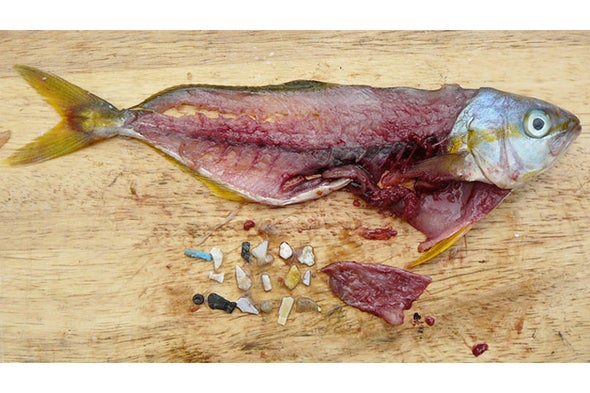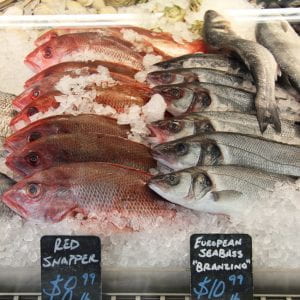Oil wells spewing crude oil into the ocean, sea turtles choking on plastic bags, and industry pumping toxic emissions into the atmosphere through their smokestacks are some of the talked about environmental problems due to the fact that they are easily seen; however, some of today’s most daunting ecological issues are comprised of things that cannot be see with the naked eye. Over the last few years the topic of microplastics within the environment, especially the role that they play in aquatic ecosystems, has been of rising concern to scientists because of the potential negative consequences that arise as a result of being consumed by fish.
What are microplastics and where do they come from?
Before we begin discussing the potential ecological impacts pf microplastics, we must first define what we mean when we say “microplastics”. If when you first read the term microplastics and the thought of tiny pieces of plastic popped into your head, then you are correct! The term microplastics can be more thoroughly defined as small pieces of plastic with a length of five millimeters or less1. There are a multitude of sources in which microplastics come from but two of the major contributors to microplastics in the environment are the natural degradation of larger pieces of plastic into smaller pieces of plastic due to exposure of solar radiation, and from the addition of microbeads to personal hygiene products2. The addition of microbeads, which are tiny pieces of polyethylene plastic used for exfoliation, to personal care products has been a practice for over fifty years until they were banned in 2015 under the Obama administration1. Research into the ecological effects of microplastics is a relatively new field of study which comes as a result of the ever-increasing input of plastic wastes into the oceans however, studies have shown that microplastics have the potential to wreak havoc on fish populations.
How are microplastics affecting fish all around the world
Since the topic of microplastics is still considered an emerging field of study, many of the effects of the microplastics on fish health are still unknown. Although this is still a relatively new field of study, several lab studies have shown a link between the ingestion of microplastics with stunted growth rates, reduced appetites, and the potential for reduced reproduction rates3. These studies have also shown a correlation between the ingestion of microplastics by larval fish and an increased mortality rate among those fish as a result of the plastic getting stuck and blocking the fish’s digestive tract3. Another study has shown that microplastics can not only affect fish populations by direct consumption, but microplastics can also decrease the population of fish food sources which ultimately can cause a shift in the population density of the fish species. This study showed that when Daphnia magna, a freshwater planktonic crustacean, are exposed to microplastics that their growth rates and reproduction rates are reduced and that these reductions are passed to the next generation which can significantly reduce their populations4. These studies have shown that microplastics can have both direct and indirect negative effects on fish populations.
Photo 1: A rainbow runner that consumed 18 plastic pieces

Credit: Dr. Marcus Eriksen Gyres Institute
Why you should care
Now, you may be thinking “I don’t even like fishing” or “I don’t eat fish so why should I care” so here are a few reasons as to why you should care about this emerging problem. Fish provide food for approximately three billion people worldwide, and with the potential of microplastics causing a reduction in the populations of many fish species world wide some areas may be subject to decreased food storages. Commercial and recreational fishing is a multi-billion-dollar industry within the US which provides a stable economic environment for many areas, so we as a nation need to try to minimize the negative effects of microplastics on aquatic ecosystems in order to maintain a stable economic well-being in those areas. We also need to realize that even if you don’t eat fish, some of your food sources may consume fish which allows for the microplastics found within fish to be consumed by you indirectly through the bioaccumulation, the process where contaminants move up the food web by consuming prey items containing the contaminants, of the microplastics5.
What can I do to help?
The major driving force which can reduce the impacts of microplastics on fish populations is to help prevent additional plastic from being introduced into the environment and to reduce the current amount of plastic already out in the environment. Every individual can make an impact to prevent an increase in the amount of microplastics in the environment by doing any of the following6.
- Reduce the amount of single-use plastics you use on a daily basis. By using reusable products, you can decrease the amount of trash that you produce which reduces the likeliness of your trash being introduced into the environment.
- Support cleanup efforts. By cleaning up litter before it reaches the ocean and other waterways, you are preventing the larger plastic items from degrading into the microplastics size categorization.
- Inform others about the potential harmful effects of microplastics. Education is key to making your efforts a success. By educating others, they will realize the importance of the issue and will likely spread the word to others.
- Lobby for bans on single use plastics and support organizations which strive to eliminate plastic pollution. Preventing the manufacturing of single use plastics can dramatically reduce the amount of plastic that ends up in the environment. It is much easier to prevent the problem than it is to try to clean up the problem.
References
1.) (2018, June). What are microplastics?. Retrieved from https://oceanservice.noaa.gov/facts/microplastics.html
2.) (N.d.) What Are Microplastics?. Retrieved from https://www.greenmatters.com/t/microplastics
3.) Parker, L. (N.d.) Baby fish have started eating plastic. We haven’t yet seen the consequences. Retrieved from https://www.nationalgeographic.com/magazine/2019/05/microplastics-impact-on-fish-shown-in-pictures/
4.) Martins, A., and Guilhermino, L. (2018, August). Transgenerational effect and recovery of microplastics exposure in model populations of the freshwater cladoceran Daohnia magna Straus. Retrieved from https://www.sciencedirect.com/science/article/pii/S0048969718308088
5.) Thompson, A. (2018, September). From Fish to Humans, A Microplastic Invasion May Be Taking a Toll. Retrieved from https://www.scientificamerican.com/article/from-fish-to-humans-a-microplastic-invasion-may-be-taking-a-toll/
6.) Hutchinson, B. (N.d.). 7 Ways To Reduce Ocean Plastic Pollution Today. Retrieved from https://www.oceanicsociety.org/blog/1720/7-ways-to-reduce-ocean-plastic-pollution-today
Image Source
1.) Thompson, A. (2018, September). From Fish to Humans, A Microplastic Invasion May Be Taking a Toll. Retrieved from https://www.scientificamerican.com/article/from-fish-to-humans-a-microplastic-invasion-may-be-taking-a-toll/


























 Park et al
Park et al Park et al 2019
Park et al 2019